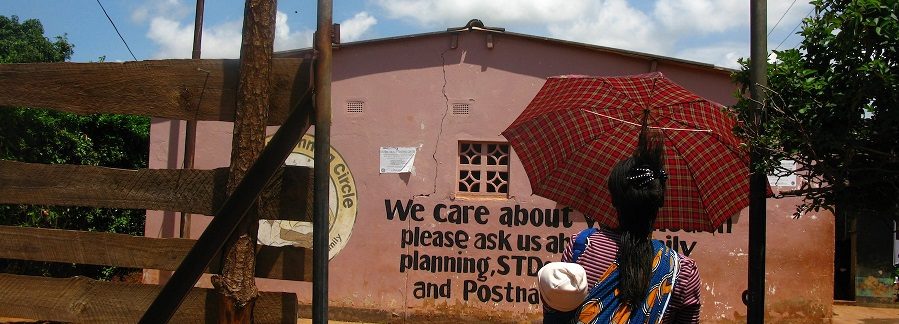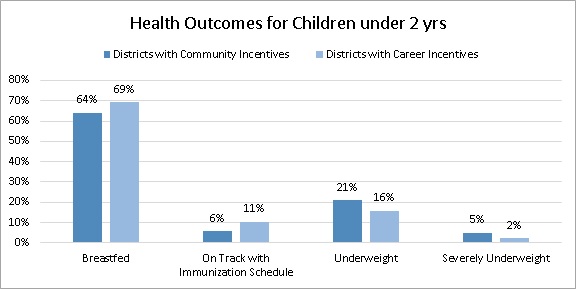
Community Health Workers Care About Career Growth
Organization : Innovations for Poverty Action
Project Overview
Project Summary
Posters and brochures emphasizing career incentives—especially the opportunity to move up to higher and better-paid positions—helped recruit new, more effective community health workers.
Impact
Community health workers recruited via career-focused messages completed more household visits, which lead to better health outcomes for women and children.
Cost
The cost was minimal for existing recruitment programs using posters.
Challenge
As the Zambian government got ready to launch their Community Health Assistant (CHA) program in 2010, the Ministry of Health wanted to evaluate and adopt effective recruitment strategies for the new cadre. The Ministry’s goal was to train 5,000 new CHAs by 2017—a massive investment in a country with only 6,000 nurses.
Recruited from their communities, trained, and then deployed back to their communities, community health workers are thought to have the necessary relationships, local knowledge, and sense of community responsibility to deliver health services to underserved areas. Informal, small-scale, community health worker programs have existed for years, but recently many countries in Sub-Saharan Africa have sought to formalize the cadre and implement national programs at scale.
Design
In each community, the district health authority posted paper advertisements for Community Health Assistant (CHA) jobs in public spaces, such as schools, churches, and the health center.

Recruitment Posters highlighting Community Incentives (left) and Career Incentives (right)
Additionally, the district health official received detailed instructions about the CHA recruitment process, including a script introducing the CHA position, a memo from the Health Secretary explaining the program, and application forms. The district health officials visited each health center and met with the staff and neighborhood health committee members to introduce the CHA program and begin recruitment using the script.
Like the posters, the scripts emphasized either career incentives—the opportunity to access higher-paid positions and “boost your career”—or the opportunity to serve the community. The latter was designed to make the position resemble existing community health workers jobs with NGOs.
CHAs were recruited from the communities where they would eventually work, trained together for one year in a central location, and posted back to their home communities after they finished their training.
Impact

A randomized evaluation found that highlighting career incentives in the recruitment posters and scripts attracted higher-skilled, but still community-oriented candidates. These skills translated into better job performance and health improvements for community members.
- Household visits: Community Health Assistants (CHAs) are expected to spend 80% of their time making household visits. During their first 18 months of work, CHAs who were recruited via a process emphasizing career incentives each averaged 94 more household visits than CHAs who were recruited via community incentives (413 vs. 319 visits). This is a meaningful difference: if each of the 147 CHAs in the community incentives group had done as many visits as their counterparts in the career incentives group, 13,818 more households would have been visited over the 18-month period.
- Community meetings: A secondary responsibility of CHAs is organizing community meetings, such as health education talks, at schools and in health centers. CHAs recruited via career incentives organized an average of 43 such meetings over 18 months, compared to CHAs recruited through community incentives, who organized an average of 22 meetings over the same time period.
- Health: The higher level of CHA activity in areas where CHAs were recruited via career incentives also translated into better health outcomes for community members—especially for women and children, who are meant to be at the center of the CHAs’ work. Children served by CHAs recruited via career incentives were more likely to be breastfed and to be on track with the immunization schedule, received more deworming treatments, and were less likely to be underweight or severely underweight.
Implementation Guidelines
Inspired to implement this design in your own work? Here are some things to think about before you get started:
- Are the behavioral drivers to the problem you are trying to solve similar to the ones described in the challenge section of this project?
- Is it feasible to adapt the design to address your problem?
- Could there be structural barriers at play that might keep the design from having the desired effect?
- Finally, we encourage you to make sure you monitor, test and take steps to iterate on designs often when either adapting them to a new context or scaling up to make sure they’re effective.
Additionally, consider the following insights from the design’s researcher:
Would this work elsewhere?
While this specific approach for recruiting community health workers has only been tested in Zambia, the project indicates that highlighting career opportunities at the recruitment stage can draw in individuals who perform well in the health sector. Further, highlighting career opportunities does not seem to attract the “wrong” candidates for community health work—the career-incentivized CHAs were just as pro-socially motivated as the community-incentivized CHAs, but they accomplished more, leading to better health in their communities. Researchers believe that these lessons may be generalizable to other contexts where the same basic conditions apply:
- Where there is a lack of formal health workers;
- Where qualified candidates exist in many communities, but the vast majority of these candidates are either not in paid employment or are in jobs below their skills level.
Cost effectiveness
Changing the emphasis of the recruitment materials should not add any cost to existing recruitment strategies and therefore may be a cost-effective way to attract more highly skilled candidates. In the longer run, however, costs might be higher if CHAs recruited with career incentives do indeed climb the career ladder and need to be replaced more frequently. Additional costs you are likely to encounter include:
- Personnel costs for training district- or state-level health officials charged with recruiting workers
- Printing costs for materials (brochures, posters, etc.)
Tools and resources for implementers
The CHA program was introduced differently to health centers depending on whether they were assigned to use the community incentives recruitment process or the career incentives recruitment process. In each district, the district health official was given a package that contained a script, a memo from the Permanent Secretary, and detailed instructions about the CHA recruitment process. In addition, district health officials received “health center packages” for each participating health center in the district, which contained a set of posters and application forms and instructions for the health center representative on how to post posters and collect applications. The district health officials were to visit each health center and meet with the staff and neighborhood health committee members to introduce the program and distribute the health center packages, using the script provided to them in their packages. The script was only provided to the district health officials, and was addressed directly to them. It is unlikely that the applicants or health center staff were able to read this script themselves.
Script given to district health officials in the career-incentives group:
To Health center and Neighborhood Health Committee: I would like to you let you know about a new government program to strengthen the country’s health workforce. Applications are currently being accepted for a new Community Health Worker position. This is an opportunity for qualified Zambians to obtain employment and to advance their health careers. Opportunities for training to advance to positions such as Nurse and Clinical Officer may be available in the future. Successful applicants will receive 1 year of training, both theoretical and practical. All training costs, including transportation, meals and accommodation during the one-year training program, will be covered by the Ministry of Health. Please encourage all qualified persons to apply so that they can benefit from this promising career opportunity.
Script given to district health officials in the community incentives group:
To Health center and Neighborhood Health Committee: I would like to you let you know about a new government program to improve health care services in your community. Applications are currently being accepted for a new Community Health Worker position. This is an opportunity for local community members to become trained and serve the health needs of their community. The new CHWs will work at the Health Post and community level in coordination with an affiliated Health center. Successful applicants will receive 1 year of training, both theoretical and practical. All training costs, including transportation, meals and accommodation during the one-year training program, will be covered by the Ministry of Health. Please encourage all qualified persons to apply so that they can benefit from this promising community service opportunity.
Project Credits
Researchers:
Nava Ashraf Contact Harvard Business School; National Bureau of Economic Research
Oriana Bandiera London School of Economics
Scott Lee Harvard Medical School; Harvard Business School


